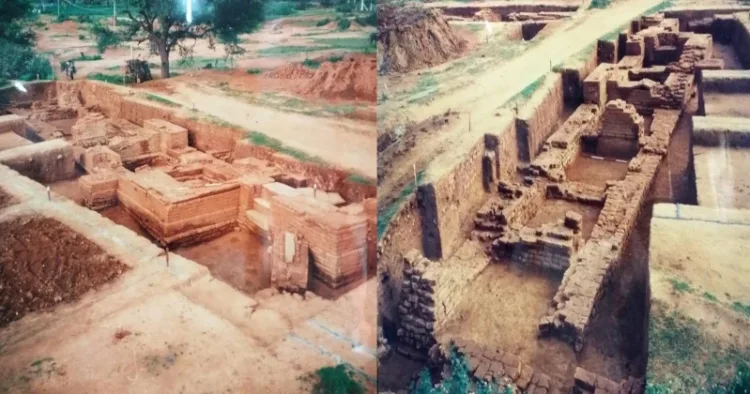In a bid to uncover the secrets of India’s rich Buddhist past, the Maha Bodhi Society (MBS) is fervently advocating for the resumption of excavations at Rajaghatta, a site nestled in the outskirts of Bengaluru. This ancient settlement, dating back to the 4th to 5th century CE, has already yielded significant relics and structures that shed light on the region’s Buddhist heritage.
The initial excavations, conducted between 2000 and 2004, were led by renowned archaeologist Prof M S Krishnamurthy. The team unearthed remnants of a Mahayana Buddhist monastery, including brick foundations, votive stupas, and a clay medallion featuring a seated Buddha. These discoveries attested to the site’s historical significance and underscored the need for further exploration.
MBS, a Buddhist charitable organisation, is now spearheading the effort to revive the excavation project. The society has petitioned the state government, the Archaeological Survey of India (ASI), and the Department of Archaeology, Museums, and Heritage to resume the excavation and protect the site for posterity.
“Initially, we appealed to the government for excavation in Rajghatta,” Dr Gopala Krishna, MBS Bengaluru coordinator, told the Organiser. There are many such sites in the country, detailed in the book Buddhist art and architecture. We will take up issues related to other sites after the excavation of Rajghatta is completed, he added.
The proposal has garnered attention from official quarters, with the state government considering the request. However, the project’s fruition hinges on collaboration between the ASI, the department, and the experts involved in the initial excavation. Prof. Krishnamurthy, now retired, has expressed his willingness to guide the excavation as an advisor, bringing his invaluable expertise to the table.
The site’s preservation is a pressing concern, as the relics unearthed during the initial excavation are not adequately protected, and the remaining areas are vulnerable to destruction. MBS emphasises the collective responsibility to safeguard this significant cultural heritage site for future generations.
ASI’s Additional Director General (Archaeology), Alok Tripathi, has indicated that a report will be prepared after examining the site, which may take several weeks. The department is open to the proposal but needs to collaborate with ASI and the experts involved in the initial project.
The rediscovery of Rajaghatta’s Buddhist past has significant implications for India’s cultural heritage. As MBS General Secretary Bhikkhu Ananda noted, “It is our collective responsibility to preserve this site for posterity. We owe it to future generations to uncover and protect our cultural heritage.”
The resumption of excavations at Rajaghatta may uncover more secrets and relics, shedding further light on India’s rich Buddhist legacy. As the quest for knowledge and preservation continues, the site’s significance extends beyond its historical importance, symbolising our collective cultural identity.
Ancient Mahayana Buddhist Monasteries have been documented in various parts of South India, including notable centres like Kanchi in Tamil Nadu and Srimoolavasam in Kerala. However, no excavation of Mahayana Monastery structures has been conducted south of Nagarjunakonda in Andhra Pradesh/Telangana. This makes the discovery of monastery and chaithya remnants in Rajaghatta particularly significant. It highlights the presence of Mahayana Buddhism in Bangalore and provides valuable insights into Buddhist practices and life in Karnataka and South India during the first millennium CE.
Rajaghatta, a small scenic village on the outskirts of Bangalore, was a Buddhist settlement from the 2nd to the 7th century CE. Between 2001 and 2004, archaeologists uncovered the remains of a Mahayana Buddhist Chaitya hall and Vihara (Monastery) in this village in Bangalore rural district. The structures were constructed with unfired clay bricks and granite pillars.
Hundreds of small clay stupas (tsa-tsa) were also found at the site. These clay stupas contain disks inscribed with Buddha images and the dharani of dependent arising in Brāhmī Sanskrit script. Mahayana practitioners typically create such stupas with relics, Buddha images, and dharanis as acts of merit. Additionally, two urns containing bone remains were discovered in the corner of the main chaitya hall, possibly belonging to accomplished practitioners. Two megalithic burial sites from an earlier period were also found a few hundred meters from the site.
Locally known as Budhigundi due to the ash mounds, the area initially did not reveal its significance to the locals. Farmers collected soil from the site, which was fertile due to the degraded human remains. Over time, they found many small stupas (tsa-tsa) and noticed that something moved inside when shaken. Hoping to find gold or other valuable items, they broke open many of these stupas. Some farmers claim that gold was found in some instances. Eventually, a local informed the archaeology department about these findings, leading to Professor Krishnamurthy’s visit and subsequent excavation.



















Comments